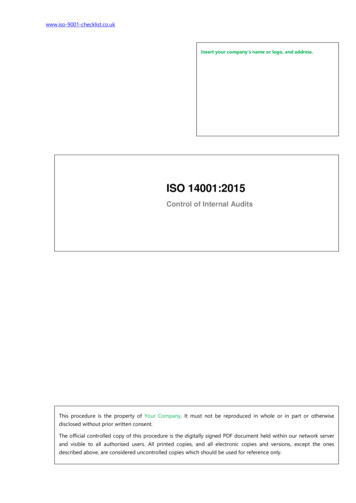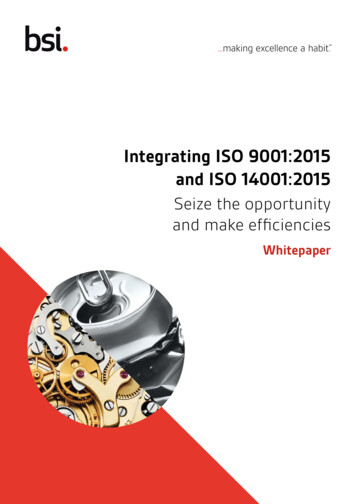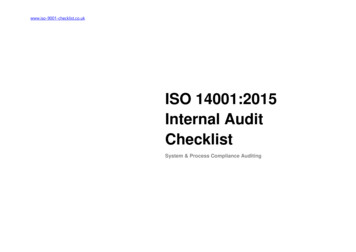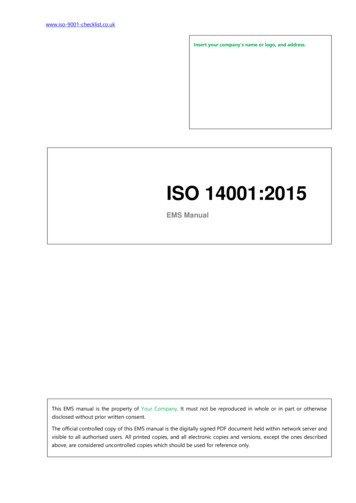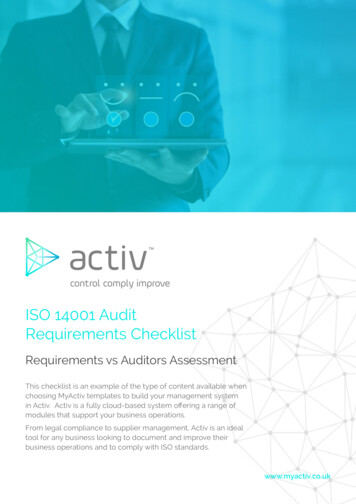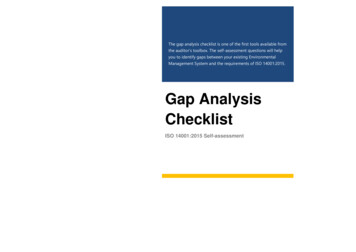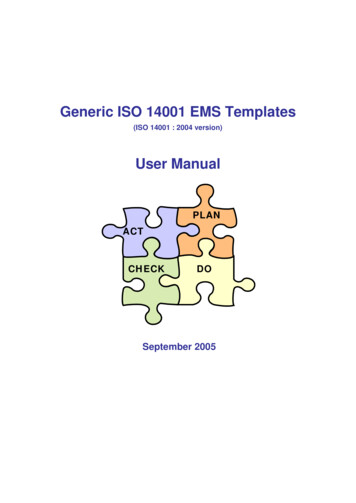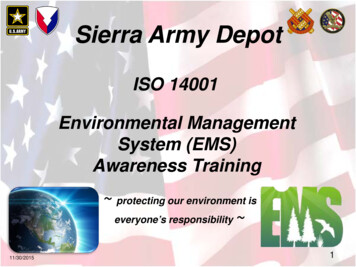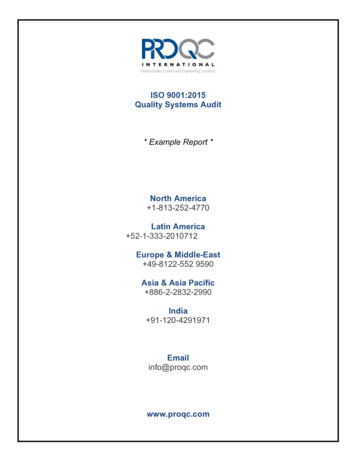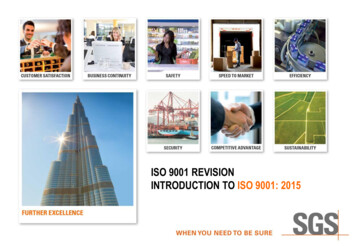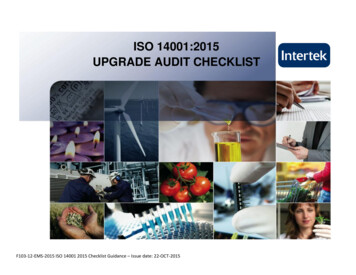
Transcription
ISO 14001:2015UPGRADE AUDIT CHECKLISTF103-12-EMS-2015 ISO 14001 2015 Checklist Guidance – Issue date: 22-OCT-2015
ISO 14001:2015 Upgrade Audit ChecklistPage 2 of 35Purpose:The purpose of this checklist is to: Help the user verify whether an ISO 14001:2004 Environmental Management System (EMS) has been successfully upgraded in accordance with therequirements of ISO14001:2015. To that end, guidance and examples of objective evidence have been provided for each clause of 14001:2015. Be utilized as a form to document objective evidence related to implementation of the new and revised requirements of 14001:2005. Highlight the standard’s:o New clauses and requirementso Changes in the Standard clauses / requirementso Need for “Documented Information”Please use below legend for interpretation of the signs provided in the context:SignDescription New Clause and/or Requirement Documented Information is requiredΔ Delta for additional requirements in clausePlease Note:This checklist is a tool to evaluate and record the objective evidence for each requirement of the ISO 14001:2015 Standard. The note sections are provided asthought starters, and examples are provided when applicable. The requirements of ISO 14001:2015 are paraphrased, and the user must take care to reviewthe ISO 14001:2015 standard to understand all specific requirements. As well, review of Annex A of ISO 14001:2015 is highly recommended.The “Yes ” box should be ticked when the objective evidence demonstrates conformity. The “No” box should be ticked if the objective evidence demonstratesa nonconformity. An “Opportunity for Improvement” (OFI) may exist in the same clause, but an OFI may not be issued for an issue which does not conform.Audit note sections are provided for references to objective evidence, interviewees, etc., and may be used in lieu of other audit note forms.F103-12-EMS ISO 14001 2015 Upgrade Checklist – Issue date: 22-OCT-2015
Page 3 of 35ISO 14001:2015 Upgrade Audit ChecklistClient Name:Client ID#:Lead Auditor:Team Auditor(s):Clause #4Client Location:Activity:Audit Date(s):Report Date/Revision:RequirementsYes NoObjective evidence / RemarksContext of the organization4.1Understanding the organization and its contextDescribe the process used by client to identify internal and external issues.Does the organisation have a high-level, conceptual1Reference objective evidence, including examples of these issues.understanding of the internal and external issues that canaffect, either positively or negatively, its ability to achieve theintended outcomes of its Environmental Management System(EMS)?1. Organization’s Issues examples:a. Environmental conditions capable of affecting or being affected by the organization. For example the impacts on / from environmental conditions likeclimate change, storms and floods, air quality, water quality, land use, existing contamination, natural resource availability, biodiversity, etc.b. External: cultural, social, political, regulatory, financial, economic, natural and competitive issues, whether international, national, regional or localc. Internal: organization’s activities, products, services, strategic direction and capabilities (people, knowledge, processes, systems) ISO140012015 20044.1N/ACommentsExamples / Objective EvidenceAuditors will need to understand the environmental conditions, internaland external issues, typically experienced in type of organisations thatcan have positive and/or negative impacts, and must be prepared andable to challenge an organization if they believe the organization’sdetermination of its context is deficient or incorrect.Evidence needs to be obtained to provide assurance thatorganizations will regularly or as necessary review and update theirexternal and internal issues. Some sources could be:The standard does not have a specific requirement that these internaland external issues, or their monitoring and review, be documented byan organization. Therefore, auditors cannot simply ask for a list of issuesor records of reviews. However, the information may be obtained fromdifferent sources within the organization.In addition to reviewing any documented process, the audit approachmust include interviews with relevant top management in relation to theorganization’s context and its strategic direction, identified issues andconditions, and how these may affect the intended outcomes of theF103-12-EMS ISO 14001 2015 Upgrade Checklist – Issue date: 22-OCT-2015Business Strategy Plan;Environmental Plan;Information provided on the organization’s website;Annual reports;Management meeting minutes;Procedure; andList of external and internal environmental issues & conditions.
Page 4 of 35ISO 14001:2015 Upgrade Audit ChecklistEMS.Clause #4.2RequirementsYes NoObjective evidence / RemarksUnderstanding the needs and expectations of interested partiesDescribe the process used by the organization to identify the interested parties.Has the organization adequately determined the interestedReference objective evidence, including examples of interested parties and anyparties and their requirements relevant to its EMS? Which ofresulting compliance obligations:these requirements are considered as organization’scompliance obligations? Notes:ISO140012015 20044.2N/AClause #4.3ΔCommentsExamples / Objective EvidenceAn ‘interested party’ is any person or organization that can affect, beaffected by, or perceive themselves to be affected by the decisions oractivities of the organization implementing the EMS.Examples of interested parties: customers, communities,contractors, suppliers, regulators, NGOs, business partners, etc.The organization has the right to decide which interested partyrequirements will be considered as “compliance obligations,” as eachinterested party may also have its own set of requirements, but not all ofthese will be relevant to the organization’s EMS.Compliance obligations must be documented, per ISO 14001:2015,6.1.3.“Compliance obligations” include: All relevant legal requirements All requirements imposed by upper levels in the organization (forexample corporate requirements) All relevant requirements of relevant interested parties that theorganization decides to comply with, whether contractually(customers) or voluntarily (environmental commitments).Auditors will have to ensure that the organization has properly identifiedinterested parties, and subsequently determined if any of their needs andexpectations will become compliance obligations. Auditors will also needto ensure that this process is revisited periodically because the relevantrequirements of relevant interested parties may change over time.RequirementsYes NoDetermining the scope of the Environmental management systemHas the organization determined the boundaries andapplicability of the EMS to establish its scope?F103-12-EMS ISO 14001 2015 Upgrade Checklist – Issue date: 22-OCT-2015Although not specifically required, objective evidence could be a listor matrix of the interested parties, their corresponding needs andexpectations, and indication of which of these accepted ascompliance obligations.In order to determine the relevancy of an interested party or itsrequirements, the organization needs to answer:Q: Will this interested party (or its requirements) have an effect onthe organization’s ability to achieve the intended outcomes of itsenvironmental management system?Objective evidence / Remarks
Page 5 of 35ISO 14001:2015 Upgrade Audit ChecklistHas the organization effectively considered the following prior todetermining the scope of the EMS? The extent of organization’scontrol and influence, context, external and internal issues,compliance obligations, physical and functional boundaries,activities, products and services? Has the organization made its scope available to all interestedparties as documented information?Notes:ISO140012015 20044.34.1CommentsExamples / Objective EvidenceAuditors will need to verify that the organization’s scope has beenestablished in consideration of organization’s boundaries andapplicability of the EMS. There is now essentially a process by which ascope must be determined; simply declaring a fenceline scope andexcluding product-related aspects without evaluating the newconsiderations is not acceptable.Evaluate the process by which the scope was determined. Reviewany process or procedure, if present. Lack of a documented processwill require more reliance on objective evidence from interviews.An organization has the freedom and flexibility to define its boundaries,as long as the top management for that (those) part(s) has authority toestablish an EMS. The scope of the EMS may include: the whole of the organization, specific and identified functions of the organization, specific and identified sections of the organization, or one or more functions across a group of organizations.Auditors may need to challenge the organization if any activities,products and services that would likely have a significant impacton the environment are omitted from the scope of the EMS. Theorganization’s scope determinations should be reasonable andconsistently applied. Note that an aspect/issue may have potentialsignificant impact on the environment but may not necessarily beidentified as a significant aspect by the organization.Auditors need to verify that the organization has considered its degree ofcontrol / influence over its activities, products and services from a lifecycle perspective. Auditors need to be aware of the differences inmeaning between “consider” and “take into account.”It is possible a manufacturing plant has little or no control overproduct design, procurement, transportation, use, and end of lifetreatment, where such are controlled by a separate coporate entity.Degree of control needs to be determined for environmental aspectsassociated with such things as procured goods and services,outsourced processes, product performance requirements, end oflife treatment (recycling, disposal, etc.).“Scoping should not be used to exclude activities, products, services, orfacilities that have or can have significant environmental aspects, or toevade its compliance obligations.” (ISO 14001:2015 Annex A.4.3 and6.1.2). This also includes the outsourced functions or processes (8.1).Example: a battery manufacturer; this would include review of theaspects/impacts related to such things such as acid and leadprocurement and delivery, use of batteries by the user, as well asrecycling and disposal.The Auditors need to ensure that the organization has made thedocumented scope available to its interested partiesVerify objective evidence of availability of the scope to interestedparties. A statement from the organizattion that the scope will beprovided upon request may be accepted as objective evidence.F103-12-EMS ISO 14001 2015 Upgrade Checklist – Issue date: 22-OCT-2015
Page 6 of 35ISO 14001:2015 Upgrade Audit ChecklistClause #4.4RequirementsEnvironmental management systemWhile establishing, implementing, maintaining and continuallyimproving the EMS;Has the organization implemented an EMS, including allrequired processes, in accordance with the requirementsof ISO 14001?Has the organization considered the knowledge it gainedfrom its context and its interested parties’ requirements?ΔNotes:ISO140012015 2004Yes NoCommentsISO14001:2015 includes specific requirements necessary for theadoption of processes when developing, implementing and improvingthe EMS. This requires an organization to systematically define andmanage processes and their interactions so as to achieve the intendedresults in accordance with both the policy and strategic direction of theorganization.4.44.1Objective evidence / RemarksA process is set of interrelated or interacting activities which transformsinputs into outputs. A procedure is a specified way of fulfilling an activitywithin a process.ISO 14001:2015, Clause 5.1, requires integration of the environmentalmanagement system requirements into the organization’s businessprocesses (i.e., Sales, Procurement, Manufacturing, Shipping, etc.).Some documented information can be used as evidence that theorganization has implemented all required EMS processes. If these areworking well for the organization then there is no need to replace them.F103-12-EMS ISO 14001 2015 Upgrade Checklist – Issue date: 22-OCT-2015Examples / Objective EvidenceAuditors should ask themselves: How well is the ‘process approach’ understood in theorganization? Is the EMS in line with the organization’s context, andrequirements of interested parties? Is it likely the established EMS will achieve its intended outcomesand enhance environmental performance? These includeenhancement of environmental performance, fulfilment ofcompliance obligations, and achievement of environmentalobjectives.EMS processes may be defined to address: Supplier, Manufacturer, Internal or External Customer issues Material, Resources, Energy, and Waste Design, Operation, Production, Logistics, etc. Activities, Products, and Services Customers, End Users Use of Turtle diagram for identifying the Process elementsExisting environmental risk assessments,Operational procedures,Work instructions, andFlow charts
Page 7 of 35ISO 14001:2015 Upgrade Audit ChecklistThere is a shift in emphasis with regard to continual improvement fromimproving the management system to improving environmentalperformance. ISO14001:2015 adds a reminder that the main purpose ofthe EMS is to enhance environmental performance. The organizationswill have to pay attention to use some environmental performanceindicators to control and monitor environmental issues, and associatedrisks and opportunities.Objective evidence should indicate that the organization hassuccessfully integrated the EMS processes in its businessprocesses. Evidence may include management reviewing EMSKPI’s as part of regular business reviews, awareness of contractorsand employees of EMS goals and expe
Audit note sections are provided for references to objective evidence, interviewees, etc., and may be used in lieu of other audit note forms. Page 3 of 35 F103-12-EMS ISO 14001 2015 Upgrade Checklist – Issue date: 22-OCT-2015
